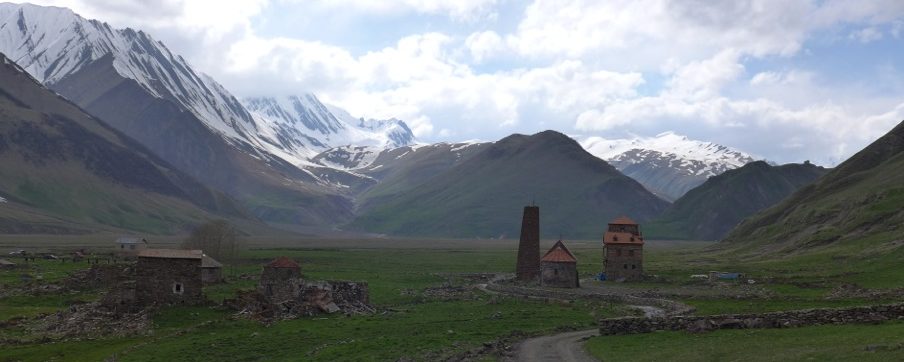Sighnaghi doesn’t really feel like Georgia. In fact, it feels like central Italy. And after a few glasses of wine, who cares? You’ve got mountain views, ancient churches, crumbling walls, and rolling hills. Life is good.
Originally built in the 18th century as a refuge from Persian and Lezgin attacks (the Lezgins came from the neighboring Dagestan mountains), Sighnaghi itself implies self-defense – sighnaghi is derived from the Turkish word for shelter, siginak.
Today, Sighnaghi has undergone a significant rehabilitation to support tourism, however its original feel has been preserved. And with its 18th and 19th century architecture, sweeping views of the mountains, and crumbling defensive positions, Sighnaghi as a day trip is hard to beat.
Come to Sighnaghi and slow down for a few hours, or a few days. And make sure to stop at the Bodbe Convent on your way out for a baptismal dip in the ice cold holy water at St. Nino’s Spring – you won’t regret it.

Time Needed
Half a day at least, though rushing through the town kind of defeats the purpose. Spending a night or two is ideal.
Distance from Tbilisi
1.5 hours
Reason to Go
This is one of the prettiest towns in Kakheti – it actually feels more like central Italy to be honest. This is also home to Pheasant’s Tears, arguably one of the best restaurants in Georgia.
Transportation
If you don’t have transportation, mashrutky run to/from Tbilisi at least six times a day for about 8 GEL. You can also get to/from regional hubs such as Telavi and Lagodekhi for even less. You’ll find the vans behind the police station on Erekle II moedani.
Accommodation
There are tons of great guest houses, though the popularity of Sighnaghi has made hotels a viable option as well. See here for details.
Food
It goes without saying that a stop at Pheasant’s Tears is a must, if not multiple meals/wine tastings there. Otherwise, new restaurants have been developed recently which are worth a shot.
Regional Combinations
Sighnaghi makes a great base for exploring “lower” Kakheti. You can knock out the recommended upper and lower loops around Telavi, spend a day or two in/around Sighnaghi, and even see visit the otherworldly cave monasteries at Davit Gareja without backtracking on your way to/from Tbilisi. Or, for those heading to Tusheti, Sighnaghi (and Kakheti in general) makes for a fabulous reward after a few nights of trekking in the backcountry. Either way, make time for Sighnaghi. It will be well worth it.

Arriving in Sighnaghi may be confusing at first – as already mentioned, it can sometimes feel like central Italy, especially after a few glasses of wine.
On a clear day, the lush, green Alazani Valley of vineyards (and sunflowers) below are flanked by the dark, menacing Caucasus Mountains beyond, separating Georgia from Russian Dagestan. Yet even with the clouds, the view is spectacular.

There are several sights worth visiting throughout Sighnaghi, most of which focus on the defensive perimeter, towers, and historic churches. Most of the 4km defensive wall still stands, including 23 towers and six gates.

Signs will point you to the accessible and walkable portions of the wall, but make sure to also visit the tiny Stepan Tsminda Church, located inside one of the towers (shown above).

Lower down the hill on the northeast side of town, you can walk atop the wall down to one of the six gates, each named after a local village.
Once you’re done inspecting the defensive perimeter, head back to the center of town and make room for a wonderful meal at the Georgian/American-owned Pheasant’s Tears restaurant and winery. This may be one of the best meals of your trip (and that is a big statement in a country like Georgia).

If possible, make sure to get a tour of their wine cellar – notice the traditional qvevri fermentation vessels buried beneath the floor, or the “womb of the earth” as the Georgians like to say. A truly ideal place for stable, cool temperatures.

The restaurant also serves as an art gallery and carpet/antique shop, in case you have any interest.
And lastly, before you leave Sighnaghi, make sure to stroll the leisurely 2km to the Bodbe Convent, the burial place of the revered St. Nino.

Originally built in the 4th century, the tiny church that stood here as a memorial to St. Nino has since been rebuilt and reconstructed several times. You can still find the St. Nino’s tomb in a small chapel in the southeast corner, partially covered in silver.

If you’re up for it (and you should be), take some time to make the peaceful descent to St. Nino’s spring in the valley below the church. You’ll descend a path of switchbacks and stairs for about 800m until reaching a small chapel built over a spring (which burst open after St. Nino prayed here in the 4th century). Pilgrims from all over Georgia come here to take a dip in the holy water, almost like a baptism, so make sure to be respectful.
Local nuns will ask you to remove your clothing and don a clean, white robe – you can change inside the chapel/chamber. Then, you’ll enter the (ice cold) water using 2-3 stairs and a handrail – the tub is no larger than a regular hot tub (but remember, the mountain water is cold.) After toweling off, take a minute to enjoy the forested valley – St. Nino chose this spot for a reason. And don’t forget – you have 800m of switchbacks and stairs to climb!
